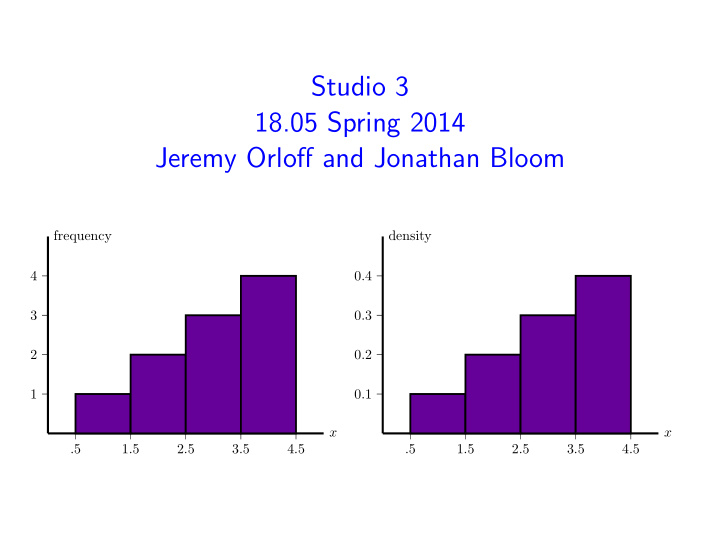



Studio 3 18.05 Spring 2014 Jeremy Orloff and Jonathan Bloom frequency density 4 0.4 3 0.3 2 0.2 1 0.1 x x .5 1.5 2.5 3.5 4.5 .5 1.5 2.5 3.5 4.5
Concept questions Suppose X is a continuous random variable. a) What is P ( a ≤ X ≤ a )? b) What is P ( X = 0)? c) Does P ( X = 2) = 0 mean X never equals 2? July 13, 2014 2 / 10
Concept question Which of the following are graphs of valid cumulative distribution functions? Add the numbers of the valid cdf’s and click that number. July 13, 2014 3 / 10
Exponential Random Variables Parameter: λ (called the rate parameter). Range: [0 , ∞ ). Notation: exponential( λ ) or exp( λ ). f ( x ) = λ e − λ x for 0 Density: ≤ x . Models: Waiting time P (3 < X < 7) .1 F ( x ) = 1 − e − x/ 10 1 x x 2 4 6 8 10 12 14 16 2 4 6 8 10 12 14 16 Continuous analogue of geometric distribution –memoryless! July 13, 2014 4 / 10
Uniform and Normal Random Variables Uniform: U ( a , b ) or uniform( a , b ) Range: [ a , b ] 1 PDF: f ( x ) = b − a Normal: N( µ, σ 2 ) Range: ( −∞ , ∞ ] 1 − ( x − µ ) 2 / 2 σ 2 PDF: f ( x ) = √ e σ 2 π http://mathlets.org/mathlets/probability-distributions/ July 13, 2014 5 / 10
Table questions Open the applet http://mathlets.org/mathlets/probability-distributions/ 1. For the standard normal distribution N(0 , 1) how much probability is within 1 of the mean? Within 2? Within 3? 2. For N(0 , 3 2 ) how much probability is within σ of the mean? Within 2 σ ? Within 3 σ . 3. Does changing µ change your answer to problem 2? July 13, 2014 6 / 10
Normal probabilities within 1 · σ ≈ 68% Normal PDF within 2 · σ ≈ 95% within 3 · σ ≈ 99% 68% 95% 99% z σ − 3 σ − 2 σ − σ 2 σ 3 σ Rules of thumb: P ( − 1 ≤ Z ≤ 1) ≈ . 68, P ( − 2 ≤ Z ≤ 2) ≈ . 95, P ( − 3 ≤ Z ≤ 3) ≈ . 997 July 13, 2014 7 / 10
Download R script Download studio3.zip and unzip it into your 18.05 working directory. Open studio3.r in RStudio. July 13, 2014 8 / 10
Histograms Will discuss in more detail in class 6. Made by ‘binning’ data. Frequency : height of bar over bin = # of data points in bin. Density : area of bar over bin is proportional to # of data points in bin. Total area of a density histogram is 1. frequency density 4 0.4 3 0.3 2 0.2 1 0.1 x x .5 1.5 2.5 3.5 4.5 .5 1.5 2.5 3.5 4.5 July 13, 2014 9 / 10
Histograms of averages of exp(1) 1. Generate a frequency histogram of 1000 samples from an exp(1) random variable. 2. Generate a density histogram for the average of 2 independent exp(1) random variable. 3. Using rexp(), matrix() and colMeans() generate a density histogram for the average of 50 independent exp(1) random variables. Make 10000 sample averages and use a binwidth of .1 for this. Look at the spread of the histogram. 4. Superimpose a graph of the pdf of N(1 , 1 / 50) on your plot in problem 3. (Remember the second parameter in N is σ 2 .) July 13, 2014 10 / 10
MIT OpenCourseWare http://ocw.mit.edu 18.05 Introduction to Probability and Statistics Spring 201� For information about citing these materials or our Terms of Use, visit: http://ocw.mit.edu/terms.
Recommend
More recommend